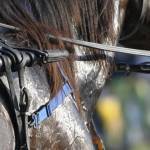Effect of Strenuous Exercise on the Equine Respiratory System

At rest, an average horse takes in approximately five liters (about 1.25 gallons) of air with each breath. It takes about 12 breaths per minute and has a heart rate of approximately 32 beats per minute. Therefore, at rest, the average horse will inhale and exhale approximately 60 liters (16 gallons) of air per minute.
Athletic performance puts extra demands on the horse’s respiratory system. During moderately strenuous exercise, the horse will increase the volume of air per breath to between 12 and 15 liters, taking over 150 breaths per minute. The lungs now have to move over 2,250 liters of air per minute, with less than half a second for each breath.
The breathing patterns of equine athletes are closely linked with locomotion. The cantering and galloping horse has respiration and locomotion locked into a 1:1 phase. With each stride, the horse will be taking a breath. This action aids in respiration, as it allows the large body mass of the abdominal organs to act like a piston. The galloping horse takes over 150 breaths per minute, efficiently moving a large volume of air in a very short period of time. Even a small increase in the amounts of mucus in the airways and minor degrees of airway spasm or thickening of the lining of the airways will adversely affect performance.
The demands of athletic exertion are not without their costs on the horse’s lungs. Training, strenuous exercise, and the stress of transport have an effect on macrophages, the “clean-up” cells that constitute one the main defense mechanisms of lung tissue. Such changes are believed to be important in explaining the increased incidence of respiratory diseases in horses exposed to these conditions. Air quality is a concern for housing, trailering, and air transport.
Horses involved in many forms of athletic exertion suffer exercise-induced pulmonary hemorrhage (EIPH). While not all horses show blood at the nostrils, a high percentage will have a small amount of blood present in the airways after their competition. This hemorrhage originates from the upper back corner of the horse’s lung. The latest research focus has been on the vascular system and blood pressure changes during exercise. Although the cause is not clear, it is known that this hemorrhage occurs commonly, and the site of hemorrhage makes an ideal location for secondary infection.








